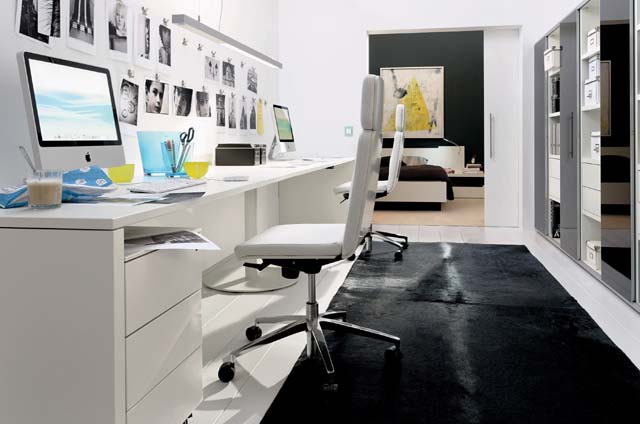
The following tips will help you set up and teach you how to organize
a home office, whether you work from home full or part time, or simply
need an efficient space to sort out bills and personal projects.
1. Choose a good spot.
You
don’t need to have an extra room in your house to have a home office.
(Though if you see clients or hold meetings there, it’s probably
preferable.) In most cases you can set up an office in a nook or corner
or even a hallway, as long as it’s relatively quiet and free of
distractions.
2. You might need less than you think.
If
you’re in the early stages of contemplating a home office, you might be
overwhelmed by images of wood-paneled rooms with leather sofas and
walls of reference books. But you really need just a desk, a chair,
whatever tech equipment your job requires, and some receptacles to
neatly hold your pens and papers.
3. But, you might need more than you think.
Make sure you have room for office supplies that you might not be used to having at home, such as extra printer paper.
Additionally, you might need to start looking at
your living space differently. A sunny apartment is enviable until the
light hits your computer screen in the morning.
A desk in your bedroom might be convenient, or it might make you too stressed about work to sleep (In fact, I highly recommend against having a desk in your bedroom if you can possibly avoid it).
4. You have more leeway.
This
is your home, so there’s no need to be stuck with – or copy - the drab
atmosphere of a cubicle farm. If you prefer your power cords hidden
away, your desk bright pink, your files in milk crates, or your whole
work area on the porch, you can do that. Go with whatever helps you to
be more productive.
5. Scale down.
In most
cases a home office doesn’t need the lumbering appliances and massive
file cabinets of an office office. You can probably get away with
smaller versions of shredders, scanners, printers, and the like. This
also frees up more room for storage or simply for living space.
6. Organize for comfort.
It’s
so important to be comfortable at work. (I spent my mid-twenties to
early-thirties working on a wooden folding chair; this was a mistake.)
But comfort goes beyond just buying a decent chair. It also means
arranging your whole environment to minimize how often you have to reach
for things on difficult shelves or crawl under your desk. Work is work,
but it doesn’t have to always feel so much like…work.
7. Organize constantly.
It’s
true of any space, but especially of an office, where you’re dealing
with more time-sensitive materials. The oft-cited rule is that a piece
of paper should only be touched once before you file it, throw it away,
or otherwise act on it. While that’s a great aspiration, it’s not always
realistic. Still, unless your home office comes with an assistant, you
do have to keep on top of your organizing. And this frame of mind can be
extended from papers to furniture. Just because you’re set things up
one way, don’t rule out rearranging or moving your work space. Change
can make you more productive.
Make sure you declutter this space regularly by knowing how long to keep documents and which documents you need to shred.
You can also challenge yourself to do a quick office organization project a few times a week, and see a lot of benefits in only 10 minutes.
8. Corral your stuff.
Shelter
magazines like to depict home offices as a sleek desk holding a skinny
laptop and maybe a vase of flowers. But if you don’t live in that
magical world, your work probably comes with stuff. Find attractive and
practical boxes, shelving, files, and holders for books, magazines,
papers, and pens. The range of these products is huge, and you can find
them from office supply stores to discount stores to fancy stationery
stores. To ensure you’re getting products that will work for you, think
about how you use your space and your tools before you buy.
Here are some picks:
9. Personalize and prioritize your walls.
The
world is full of pictures of office decoration ideas to draw from, but
you probably can’t use them all. (I love the look of bulletin boards
covered in inspirational tear-sheets, but I’m a writer, not a stylist,
so I don’t have one in my office-corner.) If scheduling is important to
you, a large calendar should be hanging prominently in your office. If
ever-changing ideas are your thing, a large whiteboard or chalkboard
might be the way to go.
10. Keep bring inspired.
Tour some famous offices’ like those of Al Gore + Anna Wintour
and you'll see that offices (whether at home or at work) really run the
gamut of neat and tidy to messy and cluttered. Make sure you choose a
style that works for you.
By Elizabeth Larkin
Personal Organizing Expert























